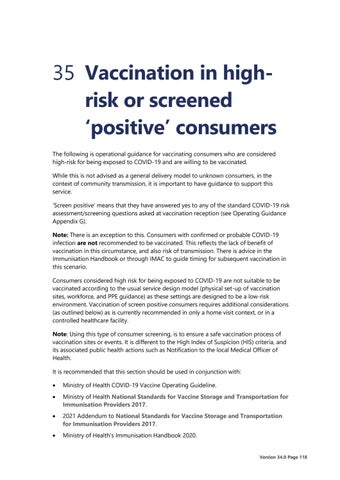Vaccination in highrisk or screened ‘positive’ consumers The following is operational guidance for vaccinating consumers who are considered high-risk for being exposed to COVID-19 and are willing to be vaccinated. While this is not advised as a general delivery model to unknown consumers, in the context of community transmission, it is important to have guidance to support this service. ‘Screen positive’ means that they have answered yes to any of the standard COVID-19 risk assessment/screening questions asked at vaccination reception (see Operating Guidance Appendix G). Note: There is an exception to this. Consumers with confirmed or probable COVID-19 infection are not recommended to be vaccinated. This reflects the lack of benefit of vaccination in this circumstance, and also risk of transmission. There is advice in the Immunisation Handbook or through IMAC to guide timing for subsequent vaccination in this scenario. Consumers considered high risk for being exposed to COVID-19 are not suitable to be vaccinated according to the usual service design model (physical set-up of vaccination sites, workforce, and PPE guidance) as these settings are designed to be a low-risk environment. Vaccination of screen positive consumers requires additional considerations (as outlined below) as is currently recommended in only a home visit context, or in a controlled healthcare facility. Note: Using this type of consumer screening, is to ensure a safe vaccination process of vaccination sites or events. It is different to the High Index of Suspicion (HIS) criteria, and its associated public health actions such as Notification to the local Medical Officer of Health. It is recommended that this section should be used in conjunction with: •
Ministry of Health COVID-19 Vaccine Operating Guideline.
•
Ministry of Health National Standards for Vaccine Storage and Transportation for Immunisation Providers 2017.
•
2021 Addendum to National Standards for Vaccine Storage and Transportation for Immunisation Providers 2017.
•
Ministry of Health’s Immunisation Handbook 2020.
Version 34.0 Page 118
